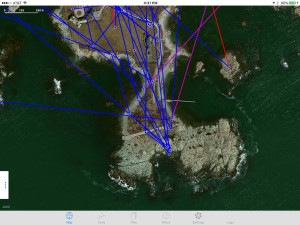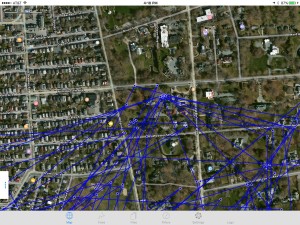The trouble with pears

Elvis, possible alpha male coyote of Newport Neck pack, trapped and waiting to be collared June 3, 2015. Photo Numi Mitchell/The Conservation Agency
This is actually painful to bring up. I don’t consider myself a picky person. However, it has come to the point that I need to mention pears. And apples, I can’t forget about apples.
This June NBCS collared a large male coyote from the Newport Neck pack we named “Elvis” (black sideburns). From video and resident reports we know his pack had at least 6 pups in the spring of 2015. By day, throughout spring and summer, Elvis stayed near the pups. They were hidden, for the most part, in rugged rocky outcrops and wooded thickets on the large estates. By night elvis patrolled his approximately 3 1/2 square mile territory (ca. 8.6 km). During some years his pack’s presence, has become a contentious issue with local residents who have an agreement with the City of Newport to allow hunting of coyotes in the area. Problems have been associated with people in portions of the territory feeding the coyotes. At the moment, however, the Newport Neck Pack members are behaving themselves pretty well. So are the Newport residents who are keeping food attractants at a minimum which in general reduces coyote problems.
The GPS locations of Elvis showed hotspots (areas with intense activity) in several areas from spring through fall. For a week or so he visited a seal carcass on Price’s Neck. Consistently however he visited boat ramps. We realized this was due to folks cleaning and dumping fish racks when they came in. All that fresh meat generated a clear attraction for coyotes and increased coyote traffic at the ramps. Elvis and his pack would regularly check by the landing at Fort Adams and King’s Beach.
The big surprise was the coyote’s penchant for pears. Apparently he loved them and, just like a property owner or farmer would, Elvis regularly checked on trees in his territory and in doing so kept other coyotes away from them. Elvis did this whether or not the trees had fruit at the time. This is amazing to consider because it suggests coyotes plan ahead for fruit season. Put more conservatively, it seems like there could be some evolutionary pressure to defend and retain portions of territory throughout the year that may only contain valuable resources seasonally.
We noticed the importance of pears because we go to every hotspot our collared coyotes visit regularly. If you connect all the gps points sequentially the path creates a star radiating from these “hotspots.” If you go to the center of the radiating lines of travel you can often figure out what they have been doing there. In case of pears it took a while to discern what the attraction was because we tend to stare at the ground looking for fur, bones, digging, matted grass, and the like. When the fruit dropped, however, the lightbulbs came on. Ripe pears with large and tiny tooth marks were scattered beneath the trees. Elvis and his pack members were gorging on the fruit. We then returned to hotspots we couldn’t figure out at the time and and looked up: “Oh, pear tree.” They also like apples.
NBCS and CoyoteSmarts (our partner group) shared the data on fish ramps with DEM and they will be erecting new signs reminding people not to leave edible waste at boat ramps. Leaving food attractants for coyotes is illegal, after all. That was easy. So here comes the difficult part. Sustainable coexistence with coyotes in urban and suburban areas means we have to clean up under our pear trees and apples – don’t forget the apples – to avoid making a coyote activity hub in your community. Sounds picky I know but I don’t make this stuff up. Look at the pictures.
We learned a lot from Elvis. Unfortunately, that ended when he was shot by a hunter in November 2015. It is sometimes necessary to euthanize habituated “problem” coyotes but it is too bad about Elvis. He was the kind of coyote you would want to keep around. He was not aggressive, was largely a scavenger, and because of his intense territoriality kept non-pack members (coyotes that might not be so benign) out of Newport Neck He was also a great study animal, more useful alive than dead. A lot of work and expense goes into trapping and collaring and tracking. While light hunting of coyotes is useful to sustain their natural fear of people, identifying and eliminating coyote food subsidies is a better way of actually controlling coyote numbers and habituation. Through their movements our GPS-collared coyotes basically tell us where the food resource problems are so municipalities can address and remove them. This reduces coyote traffic and boldness and make safer communities. NBCS asks that hunters avoid taking these useful collared tracking coyotes whenever possible.













